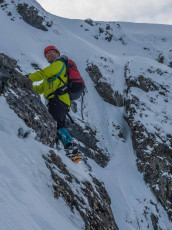
The Meet has, for the past decade at least, been organised by a man I like to call ‘King of the Darrans’. Alistair Walker’s modesty probably means he doesn’t like that title. There have been and still are other high achieving climbers very active in the Darrans. But Al’s understated, yet utter passion for the place, combined with his unwavering commitment to sharing it with others, sets him apart in my view.
Along with co-author and climbing buddy Steve Skelton, Al released a new winter climbing guide to the Darrans at the 2015 Meet. It documents every kind of climbing – rock, ice, mixed; from moderate to extreme difficulty. At the Meet itself, he treats all comers in the same welcoming, inclusive way. And he goes out of his way to get newcomers involved and hooked up with climbing buddies. Al’s philosophy - “Just the fact that you’ve made the effort and commitment to climb in such an intimidating place, in winter, is good enough for me”.
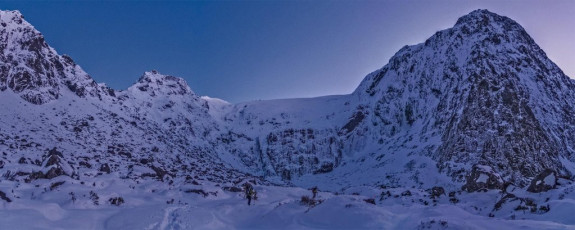
On my first day, Sunday, the conditions remained good, although a biting wind got up later in the day. I teamed up with some others to try the route up Talbots Ladder, over Mount McPherson and out via Gertrude Saddle – one of the growing collection of routes in my unfinished business file. Due to a late start and, in my view, overuse of the rope, we ran out of time just beneath the top of Talbots Ladder and had to retreat. A lot of standing in belay stances in freezing conditions resulted in a dead left big toe, which took many weeks after to fully thaw. But it was glorious up there above the Homer Tunnel and I enjoyed, albeit somewhat enviously, photographing some in our party snowboarding and skiing off Homer Saddle into a beautiful dusk. This picture, on the approach to Homer Saddle - Mt McPhearson left of centre and Mt Talbot right.
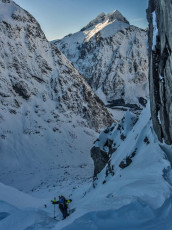
View from Homer Saddle, with Mt Crosscut behind.
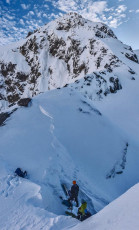
The view from Homer Saddle, up Talbots Ladder.
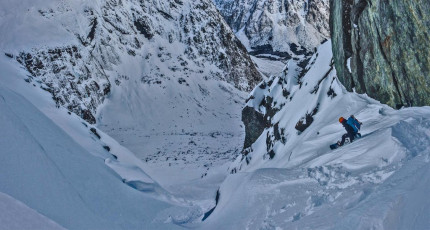
Lincoln Quilliam launching off Homer Saddle (1,375m). Whatever you’re in to – rock, ice or mixed climbing, skiing, snowboarding, from moderate to extreme, the Darrans have it. During the Meet, with Alastair McDowell, Lincoln put up a new 600m route – Freycinet, in Cirque Creek, beneath Mount Crosscut.

Above Homer Saddle, on the lower section of Talbots Ladder.
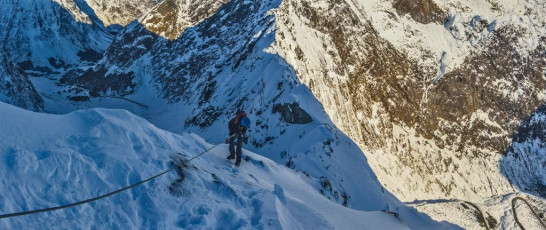
Retreating down Talbots Ladder, with sections of Highway 94 either side of the Homer Tunnel appearing as a ribbon below. Depending on who you talk to, this little exposed ridge above Homer Saddle, leading on to the tops is “an exposed hike”, through to “the crux of the Crosscut/Barrier/McPherson traverse”. In summertime it may be just a hike, but it is still highly exposed and steep. In winter, if the weather and/or snow conditions aren’t right, then getting up it is far from assured. It took me three winter attempts before finally getting up and over.

Mount Belle at dusk, from Homer Saddle.
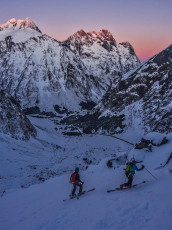
Skiers below Homer Saddle at dusk. Mts Crosscut and Christina behind.
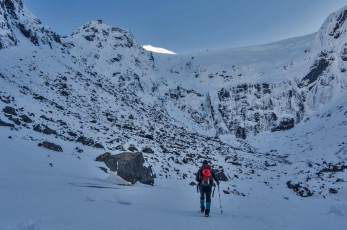
On the Monday I got to do a little ice climbing with the King himself, on the lower section of Midnight Cowboy, in the McPherson Cirque. Adding to the occasion was what was unfolding to our right, on much more challenging ground. Steve Fortune and Ben Dare captivated us with a fine demonstration of hard climbing on their new route ‘Ether’. Apparently the minimal protection and limited belay points made it a committing and scary climb – no kidding!
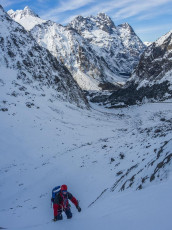
Climbing on Midnight Cowboy, with Mounts Crosscut and Christina behind.
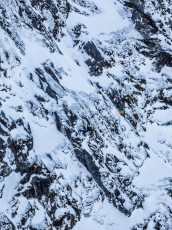
I must confess to have been somewhat daunted by the caliber of some of the climbers at the Meet. Aside from Al and Steve, others had been, or were to be, impressively fruitful on challenging new and little climbed existing routes during the Meet.
Along with Al and Steve were a ‘hard core’ of Darrans climbing stalwarts, who seemed to get together frequently. Lean and muscled guys like Steve Fortune, Ben Dare, Reg Measures and Alistair McDowell also put up new routes during the Meet.
In this picture, Steve Fortune and Ben Dare midway up the first ascent of Ether. This new route, on the lower McPherson cirque wall, traces a dramatic left-angling groove between Rabbit Run and Stirling Moss. Steve and Ben had also put up a new route earlier during the Meet, in the upper McPherson cirque, on a water ice line named Crystal Ship. It’s impressive to see just how much leading edge climbing can be achieved when climbing activity is concentrated via a forum like the Winter Meet.
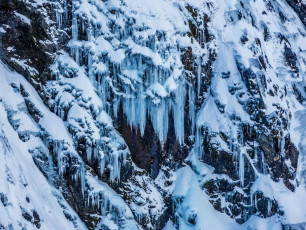
The Darrans in winter. To quote from Al Walker and Steve Skelton’s winter climbing guide – “The Darrans will test you. To climb successfully here requires a greater level of commitment than the rest of New Zealand’s mountains. Your patience will be stretched waiting for useable conditions, as will your ability to read and understand the mountains. Your whole psyche may be put on the line. But when you’ve done one of the big classics such as Cul De Sac, you’ll know you’ve achieved something.”
By Monday evening the weather was turning. Clouds descended, just as the freezing level sky rocketed and, soon, we were enveloped in thick clag. It wasn’t long before the icicles hanging from the hut’s spouting crashed to earth and the heavy wet snow on the roof avalanched. Time for some hut-bound down time – or not.
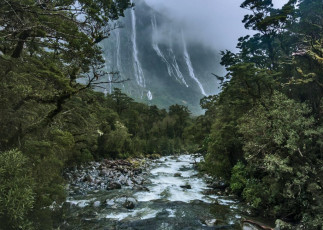
Aside from the drive up access to Homer Hut, another plus about being based at Homer Hut is that Milford Sound is just down the road. And if it’s wet, there’s no better time to see this natural wonderland. If you can’t climb, go site seeing. What had been sheer, ice plastered walls became fluid, silver faces, with huge volumes of water pouring down from the tops. On Tuesday the clag remained, so I took a short drive back down Highway 94 in the direction of Te Anau, parked the car and sloshed my way up into Cirque Creek for looksee.
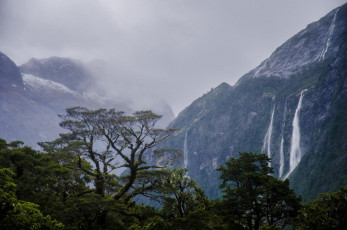
When it rains, it pours. If the weather is no good for climbing then it’s almost certainly still going to offer spectacular photography. There are a wealth of scenes to choose, but the challenge is keeping your camera dry.
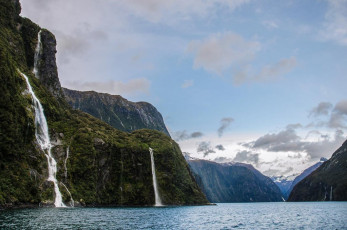
Milford Sound
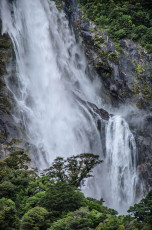
Bowen Falls, Milford Sound
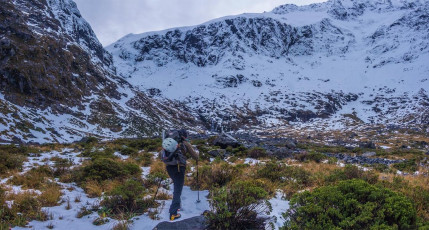
Wednesday saw improving conditions so Tom, who had just come in from Christchurch and I, agreed to team up to try for Mount Talbot, via Gertrude Saddle. We got away at dawn and made steady progress up towards the Saddle. Above the Black Lake we came upon Reg’s ski tracks of a few of days before. He had taken a day off from ‘serious climbing’ to solo Talbots Ladder and ski tour across Traverse Pass and down Gertrude Saddle, all in seven hours – hmmm. As we went, our concern grew about the snow conditions, which were like wet concrete and not improving as we ascended.
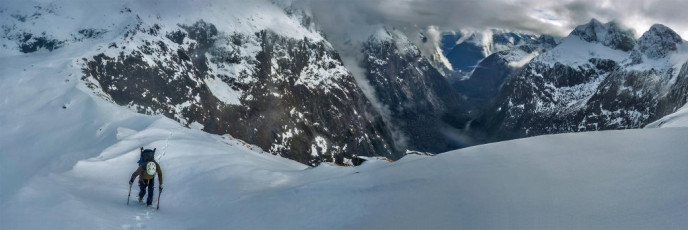
At Gertrude Saddle, the dramatic view north was at least some consolation for the unimproved conditions underfoot. We could also hear avalanche action out in the mist, so made the call that Barrier Knob, much closer and requiring just ridge climbing, was a better idea than Mount Talbot that day. Up through swirling mist and snatches of sunlight, revealing big walls and summit glimpses, we went. In this picture, commencing the climb above Gertrude Saddle to Barrier Knob

At nearly 1,900m, on top of Barrier Knob, the snow was still like wet concrete and the avalanches continued to rumble. Mount Crosscut is distant centre. At least we got up something.
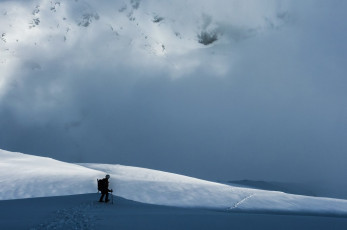
Descending to Gertrude Saddle.
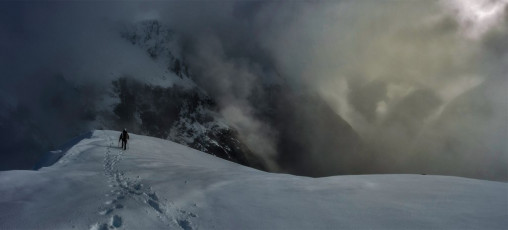
Just above Gertrude Saddle.
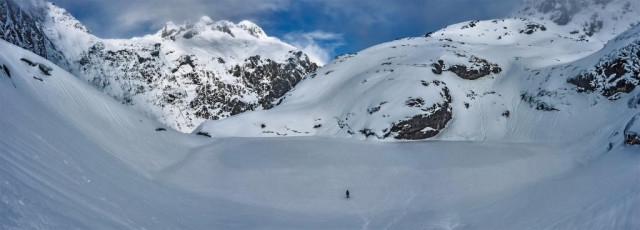
Crossing the frozen Black Lake.
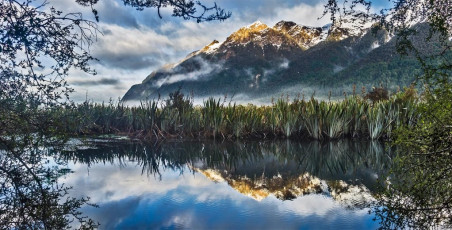
On Friday morning a pleasant stop at the Mirror Lake on the way back to Te Anau, before all the tour buses started arriving, provided further joy for the photographer in me. Rain or shine, climbing or not, this is a part of New Zealand that cannot fail to impress. And if you’re an occasional climber like me, perhaps you should make a note in your diary for next July. Maybe I’ll see you there, but remember, spaces are limited.









